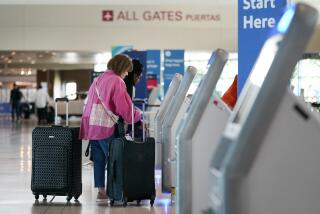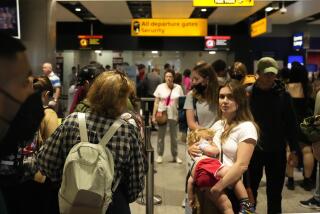Tourism to Pacific Rim Quietly Increases Sharply
- Share via
Did you try to get an airline reservation? Did you fly to Europe this summer? If so, then you know that getting a seat on a plane or finding a hotel room in London, Paris or other European destinations has been no easy task.
Last year many Americans stayed home. This summer, however, tourists have returned to Europe in large numbers.
At the same time, while hoteliers in Rome and Greece, and airline chiefs in Stockholm and London, are thanking the travel gods for their good fortune, there’s been another, and possibly more significant, development.
Traffic also has been extremely heavy to destinations in Asia and the Pacific Rim. Quietly, the area has become an equally attractive and financially much more reasonable travel alternative.
Why the sudden Pacific Rim travel surge?
“For one thing,” says Robert Reader, a spokesman for UTA French Airways, “Americans like to travel to places that are safe. The Pacific Rim fills that need. The region is relatively stable politically, and terrorism is virtually non-existent.”
UTA is one of the airlines that are adding routes and flight frequencies in the Pacific, with a strong emphasis on the islands of French Polynesia.
In the South Pacific, the travel boom to places such as Sydney and Melbourne has already been in high gear for nearly two years. But now Americans are beginning to discover the rest of Australia.
In 1985 the government of Queensland commissioned Boeing Commercial Aircraft Co., a division of Boeing Co., to project tourism for the state through the year 2000.
“What they found has put us all into a state of shock,” says Megen Bell, a spokesperson for the Queensland Tourism Commission. “Queensland has been projected by Boeing to be among the fastest-growing tourist markets in the world.”
The Boeing study projects a need for 600 more hotels by 1995 for the more than 20 million expected visitors to Queensland.
Lufthansa executive board member Frank Beckmann predicts that the Asia Pacific region will represent a third of the world’s air traffic by 1995. (Beckmann also says he expects Europe’s share to drop from 44% to 29%.)
Already, the statistics seem to support this. Visitor arrivals at Singapore increased by an impressive 5.3% in 1986 and U.S. tourists in New Zealand increased 31% in the last year. So many Americans are flying to New Zealand that they outnumber that country’s Australian visitors.
For the past few months Qantas and other airlines have been promoting a round-trip air fare of $896 from the West Coast. And even though that fare will rise to a minimum of $1,096 on Oct. 1, it’s still a great deal, and often it includes free stopovers in places that dot the United States to Australia flight route.
As a result, just about every major U.S. airline seems to be vying for a new Pacific or Asia route.
American started service two months ago from Dallas to Tokyo. Delta is pushing hard for a route to Seoul, South Korea. Continental is firmly entrenched in Australia. And United has added routes to Taipei, Seoul, Singapore and Bangkok.
Asian-based carriers already flying to the United States have quietly increased their frequency.
Singapore Airlines now flies 10 times a week to Los Angeles. Cathay Pacific flies 747s between San Francisco and Hong Kong (via Vancouver, Canada) and has ordered long-range 747s to begin Asian routes to other U.S. cities. And carriers such as Malaysian Airlines System and Garuda now fly regularly between the United States and Kuala Lumpur and Jakarta.
Last year All Nippon Airways, the biggest domestic airline in Japan, started service to Los Angeles and Washington. ANA has now increased its flights from the West Coast to Japan to a daily service. Recently the airline started connecting service from the United States to Hong Kong via Tokyo. ANA also flies between Tokyo and Dalian, a fascinating Chinese port city on the Yellow Sea.
“Our forecasts tell us that the numbers will dramatically increase across the Pacific,” says Richard Boynton, ANA vice president of sales and marketing for North America.
“Although the high yen is having an effect on tourism to Japan,” Boynton said, “it is being counterbalanced somewhat by Americans who don’t necessarily want to go back to Europe this summer. We are expanding rapidly because we are seeing a dramatic increase in the number of first-time Asia travelers.”
With new airlines and increased frequencies comes increased competition. ANA, for example, has focused a substantial amount of its marketing efforts on the United States.
As a result, the 747s it uses on the route are new (the airline recently ordered 11 more Boeing 747s), and interiors of the aircraft are designed with great service in mind.
ANA’s coach service to Tokyo often rivals other carriers’ business-class service.
American’s new service from Dallas to Tokyo features two specially equipped 747SP (special performance) planes. The aircraft are not only equipped with stand-up bars and more comfortable seats but also with extra flight attendants.
The 747s also are configured differently--only 29 seats in first-class, 78 in business-class and 78 in coach. There are fewer coach seats on these planes than on any other plane in the American Airlines fleet.
Lately the planes have been flying at only 40% capacity, and the ratio of flight attendants to passengers is luxurious: one attendant to every six passengers.
Thai Airways is offering incredibly attractive air/ground packages to Bangkok.
“In years past,” says Chatrachai Bunya-Ananta, the airline’s executive vice president, “the Americans who came to Thailand were either backpackers or older folks who had the time to see the country. Now the demographics are changing. We’ve built up our tourism infrastructure and we’ve built more hotels and attractions, but the prices haven’t risen considerably.”
“As a result we’re getting a lot of first-time vacationers, and now we’re in a position to really show off our country.”
(A super APEX coach ticket on Thai Airways from New York to Bangkok offers free stopovers in Tokyo and Hong Kong and costs $1,370.)
Even European airlines are getting into the Asia act. British Airways and British Caledonian offer new nonstop flights between London and Hong Kong. And twice each week, British Airways flies nonstop between London and Tokyo.
Lufthansa is building a major airline maintenance complex in Beijing in conjunction with the Peoples Republic of China. Lufthansa also is building a hotel in a joint venture with the PRC.
But nowhere is the Pacific boom being seen more than in hotel development and construction. For example, Hilton has opened the Conrad, a 575-room hotel on the Gold Coast of Australia. Another is planned to open in Hong Kong in 1990. Sheraton will open four hotels in the South Pacific by the end of this year.
Ramada has targeted the Asia/Pacific region for its fastest growth. There are now seven Ramadas in Australia and Singapore and another eight Ramada properties with more than 3,000 rooms are under construction in Japan, China and Hong Kong.
More to Read
Sign up for The Wild
We’ll help you find the best places to hike, bike and run, as well as the perfect silent spots for meditation and yoga.
You may occasionally receive promotional content from the Los Angeles Times.






